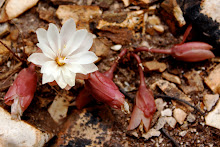The Deschutes is a predominantly ponderosa pine forest and in its northern sectors, other species of conifer peek in, such as Doug Fir. Chinquapin and snowbrush dominate the understory, chinquapin with its sharp, cactus-like seed pods and snowbrush with its thick spicy scent. The ponderosa forest is a dry forest, much unlike the beech, tulip poplar, and walnut forests of my childhood. Wildflowers here are fleeting, as are the mysterious morels, in the spring months when the snow has melted but there are still heavy rains.
Morels are prized for their taste and the hunt that one must partake in to find them. They are small, brownish-gray mushrooms with a "honeycomb" look to them. They have a white stalk and come in a variety of sizes, though a 4-5 inch morel is a biggie. Morels, so far, cannot be propagated by humans and so if you want them, you'll either pay an exorbitant amount of money ($30 per pound, here) or you'll go morel hunting.
Now, morel hunting may sound easy, but I'll remind you that they are the exact color of a forest floor covered in pine needles and they tend to be found where Doug Firs are. At first I thought nothing of 8 million Doug Fir pinecones lying all around, but the fact is that it's unbelievably easy for the eye to mistake the pinecones (especially if they happen to be half-buried in the duff) for a morel. I found that my eyes needed to look for a conical, soft shape, and that scanning for hours means you almost never take your eyes off the ground. They like a little sun, though not too much (based on where we found them), and definitely more moisture than a summer forest would see.
After about four hours we had only collected a few pounds, and we had fun. It's tedious, exhausting, sometimes frustrating, but rewarding and gratifying at the same time. In fact, I've essentially just described my experience huckleberry picking last year. It seems that this is the case for a fair amount of wild harvesting, but at the end of the day, you've worked hard and earned some food. Some food, I'll remind you, that you only had to pay gas and time for. I'm really loving this learning process of wild foraging - not only do you get to eat "free" and "organic" foods right out of the forest, but you get to see so much more. Below you will find some incredibly beautiful wildflowers that I've never had the pleasure of seeing in the wild before.
Trillium
Calypso Orchid
Gooseberry (Ribes genus)
Trillium
Crab spider with hot pink stripes, hanging out on trillium leaf
More shrooms.
A False Morel, toxic











1 comment:
ahhhh morels!!! i haven't found any yet, i found a few beautiful violet cups, thought there would be some morels around, there probably were but its hard to concentrate with the kiddos with me!! nice work, i hear morel hunting is challenging out here :) <3 Kate
Post a Comment